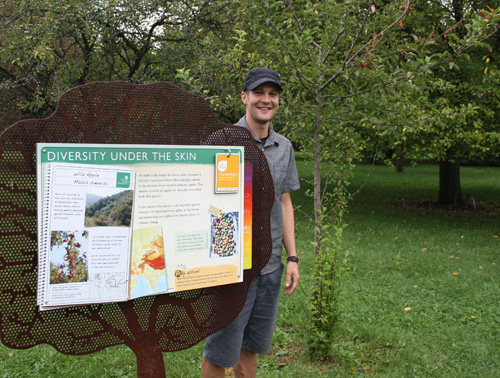
Think of endangered species, and you might think of pandas, gorillas and whales. But trees?
Think again, says Prof. Shelley Hunt, director of the U of G Arboretum.
Around the world, more than 8,700 known tree species face extinction – about 10 per cent of all kinds of trees on Earth. Almost 80 species of trees have gone extinct over the past century, victims of over-exploitation, human development, climate change, invasive species and pests.
Those are among the messages you’ll read in a travelling outdoor exhibit appearing in the Arboretum until the end of October. This is the first Canadian visit for “Vanishing Acts,” an exhibit about endangered trees that was compiled three years ago by the Morton Arboretum in Chicago.
The exhibit arrived in Guelph in July.
Its goal is “to bring attention to the plight of endangered trees around the world,” says Hunt. “We don’t always think of trees as the top of the list of endangered species. Trees are the foundation of a lot of ecosystems. The loss of tree species could have a trickle-down effect.”
The exhibit consists of 17 tree-shaped metal panels erected along the Ivey Trail and the main trail through the Arboretum’s World of Trees collection. Each panel bears an interpretive plaque with information about individual species and the value of trees.
The panels were “planted” by Arboretum horticulturist Sean Fox. “We have tried to place the signs next to the actual tree growing in the Arboretum,” he says. “However some of the trees don’t do well in the cold, so when we don’t have the specific tree, we place it close to its relatives. Of the 15 trees that are highlighted in the exhibit, we have seven of them growing in the Arboretum.”
Adds Hunt: “It’s an outdoor exhibit. You’re actually walking around among the trees.
Most panels address a single species of rare or threatened tree from different parts of the world. One panel called “Ancient Chinese Medicine” discusses how overuse of bark for medicine has nearly wiped out much of the Houpu magnolia in China.
The dawn redwood was once the most common form of sequoia in North America. Thought to be extinct, it was found in China in the 1940s, according to a panel called “Fossil Discovered Alive.”
Overharvesting, fires and land clearing have endangered the monkey puzzle tree, revered by Chileans and one of the most primitive conifers alive.
The pau brasil tree grows only in Brazil and is used for making stringed instrument bows. Today it occupies only about five per cent of its original range.
Other species in the display include the Pacific yew, Wollemi pine, Fraser fir, Serbian spruce, big-leaf mahogany and wild apple.

Photo by Deirdre Healey
The Arboretum responded to a call for host institutions for the exhibit. The display meshes with the Arboretum’s goals in education, outreach and plant conservation, says Hunt. An ecologist in the School of Environmental Sciences, she was appointed to the Arboretum earlier this year.
“Most arboretums and botanical gardens have mandates that extend beyond gardens to work to preserve trees and plants,” she explains. “We’re always looking for ways to bring information to people in interesting ways.”
Her first-year environmental sciences class toured the exhibit this fall.
“I have encountered lots of people looking at the panels,” she says.
The Arboretum has a collection of rare and endangered trees from Ontario – no Ontario trees are extinct. It also has representatives from almost 70 plant families in its World of Trees collection, including many species featured in Vanishing Acts.
Most provincial species are represented in a gene bank and are grown on the grounds, including blue ash, eastern flowering dogwood and butternut. Arboretum staff members have collected seeds and share seeds in turn with organizations for replanting around Ontario.
The Morton exhibit is produced in partnership with the Global Trees Campaign, which works to save threatened trees.